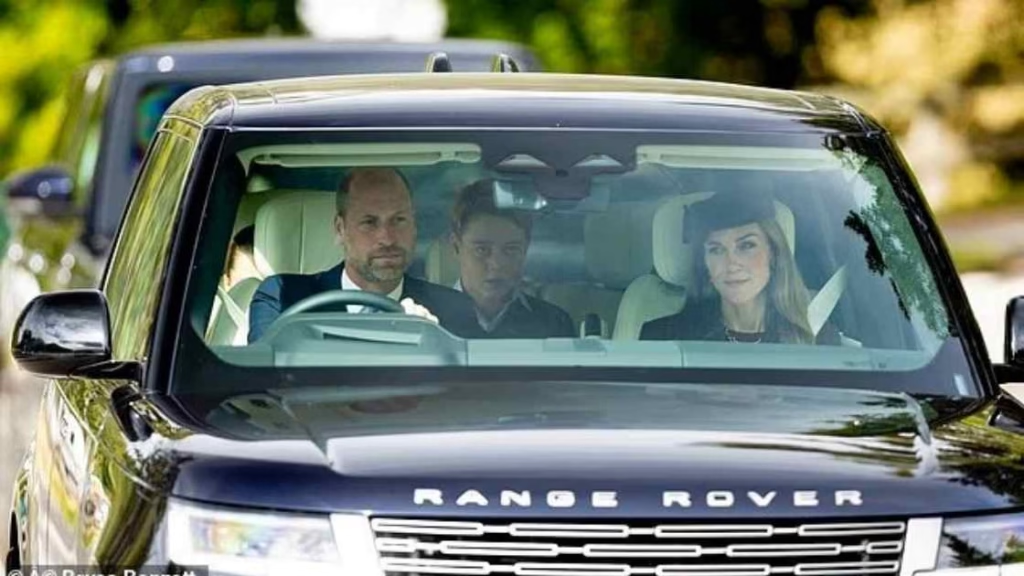How the Wales Children Are Reshaping the Future of the British Monarchy.
As Prince George approaches his teenage years, Princess Charlotte breaks royal barriers, and Prince Louis charms the world with his spirited personality, the next generation of royals is already making their mark on the House of Windsor
By Royal Correspondent
The morning sun filters through the ancient windows of Windsor Castle as three young voices echo down the corridors that have witnessed centuries of royal history. Prince George, 12, Princess Charlotte, 10, and Prince Louis, 7, are not just any children – they represent the future of the British monarchy, and they’re already proving that this new generation will do things differently.

A Modern Royal Childhood
Gone are the days when royal children were seen but not heard, tucked away in nurseries with stern nannies and rigid schedules. The Wales children live a life that balances royal duty with refreshing normalcy, thanks to their parents’ determination to give them as grounded an upbringing as possible.
“William and Catherine have created something truly special,” observes royal historian Dr. Margaret Thornley. “These children attend regular schools, play sports with their classmates, and yes, they still have chores at home. It’s a far cry from the isolated childhoods of previous generations.”
The evidence is everywhere. Prince George plays football with his local team, Princess Charlotte has taken up rugby – a sport traditionally dominated by her male relatives – and Prince Louis is known for his love of gardening, often spotted helping his mother tend to the kitchen garden at their Norfolk home, Anmer Hall.
Charlotte: The Trailblazer
Of the three siblings, it’s Princess Charlotte who seems destined to break the most ground. As the first royal daughter to retain her place in the line of succession regardless of any future brothers (thanks to the 2013 Succession to the Crown Act), she represents a historic shift in royal protocol.
But Charlotte’s significance goes far beyond legal precedents. At just 10 years old, she’s already shown a fierce independence that delights royal watchers. Whether she’s confidently walking ahead of her brothers at public events or passionately cheering for the England women’s football team, Charlotte embodies a new kind of royal confidence.
“She has this wonderful spirit,” notes royal biographer James Whitmore. “You can see she’s completely comfortable in her own skin, whether she’s curtsying to her grandfather the King or pulling faces during a church service. That authenticity is going to serve her well.”
Recent public appearances have showcased Charlotte’s growing poise. At Wimbledon, she sat with perfect posture in the Royal Box, but wasn’t afraid to show genuine excitement when her favorite players scored important points. At the women’s European Championship final, she was photographed signing her first official royal message, a confident “Charlotte” alongside her father’s “W.”
George: The Reluctant Heir
As second in line to the throne, Prince George carries the weight of future kingship on his young shoulders, though his parents are careful to let him simply be a child for now. Those close to the family describe a thoughtful, slightly serious boy who is acutely aware of his destiny but not burdened by it.
“George understands his future role, but William and Catherine are brilliant at making sure he has a normal childhood first,” reveals a family friend. “He loves football, plays video games with his friends, and yes, he argues with his siblings just like any other brother.”
The future king has been gradually introduced to royal duties, attending major events like the Queen’s Platinum Jubilee and his grandfather’s Coronation. Each appearance shows a boy growing more comfortable with public attention, though he still occasionally seeks reassurance from his parents during formal occasions.
Louis: The Wild Card
If George is the steady future king and Charlotte the confident trailblazer, then Prince Louis is undoubtedly the family entertainer. At seven years old, he’s become a social media sensation without even trying, thanks to his uninhibited reactions to royal events.
Who could forget his scene-stealing performance during the Platinum Jubilee celebrations, where his animated faces and playful antics captured hearts worldwide? Or his enthusiastic waves from the Buckingham Palace balcony, completely unbothered by the formal protocol surrounding him?
“Louis brings such joy to every occasion,” laughs royal photographer Helena Crawford, who has captured the family at numerous events. “He’s genuinely funny, completely natural, and he reminds everyone that these are real children having real experiences, not just royal props.”

A Family United
Despite their different personalities, the three Wales children share an unmistakable bond. They’re often photographed holding hands, sharing whispered jokes, or looking out for each other during public appearances. This sibling closeness reflects their parents’ success in maintaining family unity despite the pressures of royal life.
The family’s approach to education reinforces these values. All three children attend Lambrook School in Berkshire, where they participate in everything from drama club to competitive swimming. Teachers describe them as polite, hardworking students who are well-liked by their classmates.
“They’re not treated differently because of who they are,” explains an educator familiar with the school. “They earn their achievements, face consequences for poor behavior, and navigate friendships just like everyone else.”
The Catherine Effect
Much of the children’s grounded approach to royal life stems from their mother’s influence. Catherine, now the Princess of Wales, has consistently prioritized her children’s emotional well-being and normal development over rigid royal protocol.
Her own middle-class upbringing informs her parenting style. The children are expected to help with household tasks, write thank-you notes for gifts, and treat staff with respect and kindness. Catherine has also been open about the challenges of motherhood, making her more relatable to parents across the country.
“Catherine understands that these children will one day serve the public,” notes royal commentator Victoria Sterling. “But first, she’s raising them to be decent human beings who understand the value of hard work and kindness.”
Balancing Act
The challenge facing the Wales family is maintaining this normal childhood while preparing the children for their eventual public roles. It’s a delicate balance that requires constant adjustment as the children grow older and become more recognizable.
Recent changes in their public exposure reflect this evolution. While Louis still enjoys relative privacy, George and Charlotte are gradually taking on more official duties. Charlotte’s appearance at sporting events and George’s attendance at formal ceremonies represent careful steps toward full royal life.
“They’re being prepared gradually,” explains constitutional expert Professor David Hamilton. “Each child will find their own path within the royal framework, but they’re being given the tools to make those choices from a position of strength.”
Global Impact
The Wales children’s approach to royal life is being watched internationally, as monarchies worldwide grapple with relevance in the modern age. Their blend of accessibility and dignity offers a template for 21st-century royalty.
Social media buzz around the children consistently trends globally, with their fashion choices, expressions, and interactions analyzed by millions. Yet their parents have managed to control this attention, sharing enough to satisfy public interest while protecting their privacy.
“They represent the best of both worlds,” observes international royal correspondent Maria Santos. “They’re relatable enough for people to connect with, but special enough to maintain the magic of monarchy.”
Looking Forward
As the Wales children continue to grow, their influence on the monarchy’s future becomes increasingly apparent. They represent a generation that will inherit an institution shaped by centuries of tradition but adapted for a rapidly changing world.
The signs are promising. George shows the thoughtfulness necessary for future kingship, Charlotte demonstrates the confidence to forge new paths, and Louis brings the authenticity that keeps the royal family connected to ordinary people.
“These children are growing up knowing they’re part of something bigger than themselves,” reflects Dr. Thornley. “But they’re also learning that their value comes not just from their titles, but from their character and contributions.”
The Royal Recipe
What makes the Wales children so compelling is their combination of royal privilege and recognizable childhood experiences. They attend glamorous events but also deal with sibling rivalry. They meet world leaders but still need reminding to say please and thank you.
This authenticity has reinvigorated public interest in the royal family, particularly among younger generations who might otherwise view the monarchy as outdated. The children serve as a bridge between ancient institution and modern values.
As they continue to grow and develop their individual personalities, one thing seems certain: the future of the British monarchy is in capable hands. George, Charlotte, and Louis represent not just the next generation of royals, but a new kind of royalty altogether – one that honors tradition while embracing change, maintains dignity while staying relatable, and serves the people while remaining genuinely human.
In an age of uncertainty, these three children offer something precious: hope for a monarchy that can evolve without losing its essence, and leaders who understand that true nobility comes from character, not just birth.
The House of Windsor’s future has never looked brighter.
This feature appears in the September 2025 issue of Tab2Mag .






